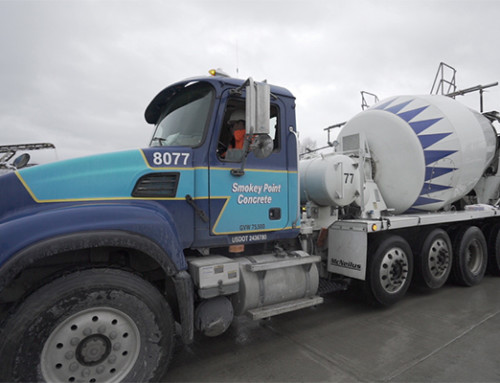Hot Weather Concrete Placement Tips:
- Remember that when temperatures are above 70 degrees, concrete set times accelerate much faster, so remember to ask for a hydration stabilizer to give you more time to place & finish the concrete.
- Consult SPC / SRM when ordering the proper mix.
- Have adequate crew, materials and equipment on hand to reduce total time between start of placing and application of curing procedure.
- Fog or sprinkle with cool water; forms, reinforcing steel and sub-grade the evening before. There should be no puddles on forms or sub-grade at placement. Sub-grade should be damp to at least 1/2” deep.
- To offset effects of high temperatures, low humidity or winds, erect sun shades and wind barriers to protect concrete from stiffening or crusting to help minimize cracking, crazing and plastic shrinkage.
- Discharge concrete as soon as possible and avoid prolonged mixing which increases the temperature of the concrete. This will make the concrete set faster and shorten the time available for placing.
- Notify SPC / SRM of any delay in placing so a hydration stabilizer can be added to the mix.
- Control evaporation during and after finishing by ordering Con-Film, an evaporation
retarder. - Moist curing or a curing compound is most needed during the first few hours after
finishing. In hot weather, continuous moist curing for the entire period is preferred. - Forms should be loosened as soon as possible without damage to the concrete. Then, water should be placed at the top exposed surfaces and allowed to run down inside the forms.
- DO NOT add excessive water to the concrete mix. Water weakens concrete and can cause scaling and/or excessive cracking. Ask for a water reducer (Glenium or Polyheed) to minimize problems and maximize strength and durability.
- ALWAYS seal concrete. Investing in a good sealer is a small price to pay to maintain the beauty and durability of your concrete.
- SPC / SRM carries a full line of architectural and decorative concrete supplies, sealers, acid stains, color hardeners and stamped concrete supplies.
Remember
If you add only one gallon of water to a cubic yard of a properly designed 3000 psi concrete mix:
- You increase the slump about one inch
- You cut the compressive strength by as much as 200 psi
- You waste the effect of 1/4 bag cement
- You increase the possibility of seepage through the concrete by up to 50%
- You decrease the freeze-thaw resistance by 20%
- You decrease the resistance to attack by de-icing salt
- You lower the quality of concrete in many other ways
If more workability is needed, ask dispatch to adjust mix.
Hot Weather Concreting Problems:
- Increased water demand
- Accelerated slump loss
- Increased rate of setting
- Increased tendency for plastic cracking
- Difficulties in controlling entrained air
- Critical need for prompt early curing
Problems with Adding Water at the Jobsite:
- Decreased strength
- Decreased durability and watertightness
- Nonuniform surface appearance
- Increased tendency for drying shrinkage
Plastic Shrinkage Cracking:
- High air and concrete temperature
- Low humidity
- High winds
Effects of High Concrete Temperatures:
- 33 lbs. Of additional water per cubic yard required as temperature of concrete goes from 50° to 100°
- Addition of water reduces strength by 12% to 15%
- Setting time can be reduced by 2 or more hours with a 20° increase in concrete temperature
Precautions for Plastic Shrinkage Cracking:
- Moisten subgrade and forms
- Moisten dry and absorptive aggregates
- Erect temporary windbreaks
- Erect temporary sunshades
- Cover the concrete between placing and finishing
- Reduce the time between placing and the start of curing
- Protect concrete immediately after final finishing
| Effect Of Temperature on Concrete Strength | ||||
| CuringConcrete | Percent of 73° F. Cured Concrete Strength At Age Indicated | |||
| 1 Day | 3 Days | 7 Days | 28 Days | |
| 73° F. | 100% | 100% | 100% | 100% |
| 55° F. | 40% | 60% | 80% | 100% |
| 40° F. | 10% | 25% | 50% | 85% |
| 25° F. | 3% | 10% | 18% | 25% |
